Leadership Management: Steward vs Charismatic Leadership Report
VerifiedAdded on 2022/08/12
|15
|3891
|20
Report
AI Summary
This report delves into the realm of leadership management, specifically focusing on steward and charismatic leadership styles. It begins with an analysis and definition of steward leadership, highlighting its emphasis on societal and community well-being, and its practical success in various organizations. The report then contrasts steward leadership with servant leadership, clarifying their differences, with the premise that all stewards are servants, but not all servants are stewards. A core comparison is made between steward and charismatic leadership, analyzing the strengths, weaknesses, and the overall impact of each style. The report emphasizes the importance of effective communication and vision in charismatic leadership while contrasting it with the more collaborative and values-driven approach of stewardship. The report concludes by emphasizing the significance of steward leadership in enhancing organizational efficiency and employee engagement.

Running head: LEADERSHIP MANAGEMENT
Leadership Management
Name of the Student
Name of the University
Author note
Leadership Management
Name of the Student
Name of the University
Author note
Paraphrase This Document
Need a fresh take? Get an instant paraphrase of this document with our AI Paraphraser
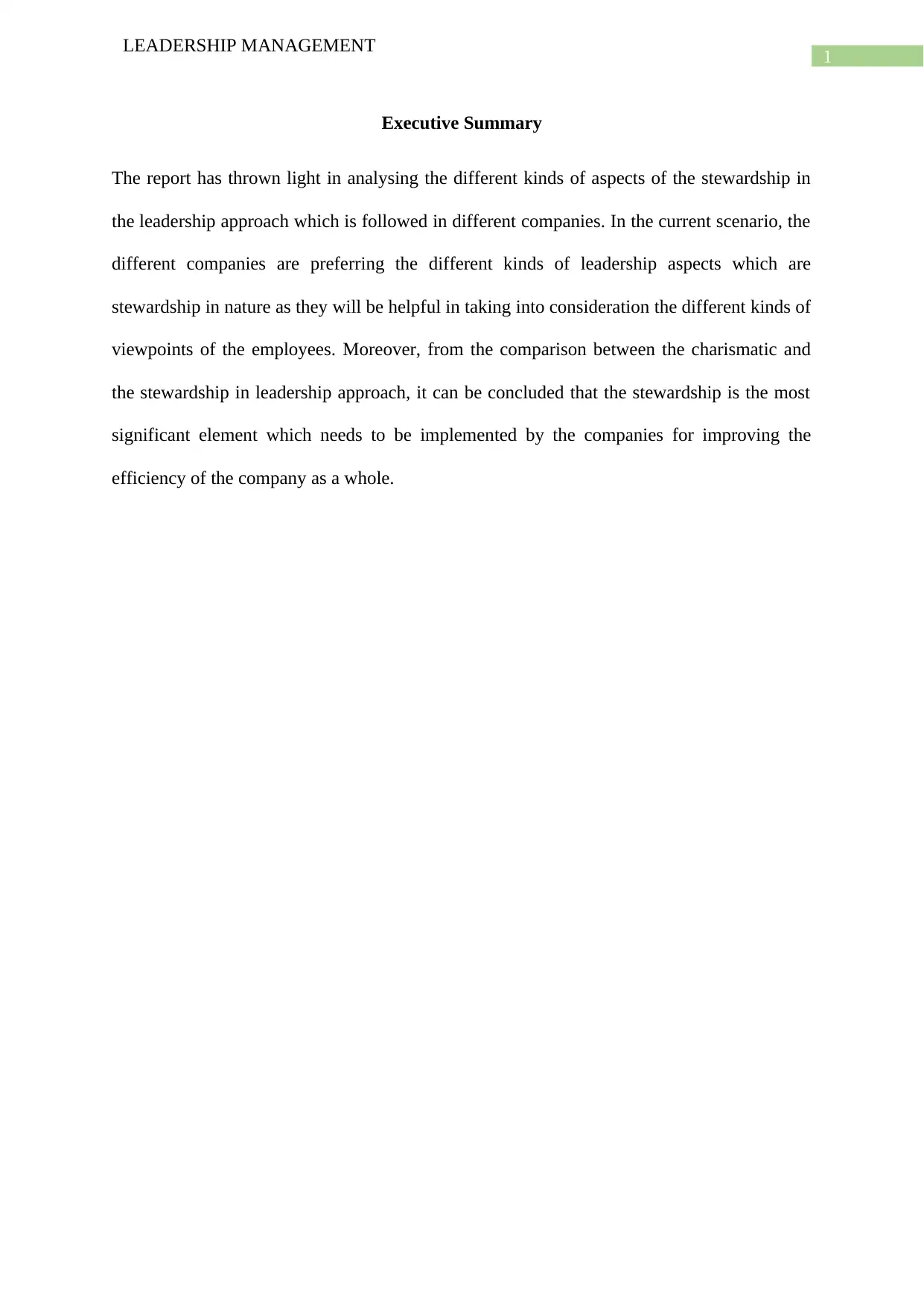
1
LEADERSHIP MANAGEMENT
Executive Summary
The report has thrown light in analysing the different kinds of aspects of the stewardship in
the leadership approach which is followed in different companies. In the current scenario, the
different companies are preferring the different kinds of leadership aspects which are
stewardship in nature as they will be helpful in taking into consideration the different kinds of
viewpoints of the employees. Moreover, from the comparison between the charismatic and
the stewardship in leadership approach, it can be concluded that the stewardship is the most
significant element which needs to be implemented by the companies for improving the
efficiency of the company as a whole.
LEADERSHIP MANAGEMENT
Executive Summary
The report has thrown light in analysing the different kinds of aspects of the stewardship in
the leadership approach which is followed in different companies. In the current scenario, the
different companies are preferring the different kinds of leadership aspects which are
stewardship in nature as they will be helpful in taking into consideration the different kinds of
viewpoints of the employees. Moreover, from the comparison between the charismatic and
the stewardship in leadership approach, it can be concluded that the stewardship is the most
significant element which needs to be implemented by the companies for improving the
efficiency of the company as a whole.
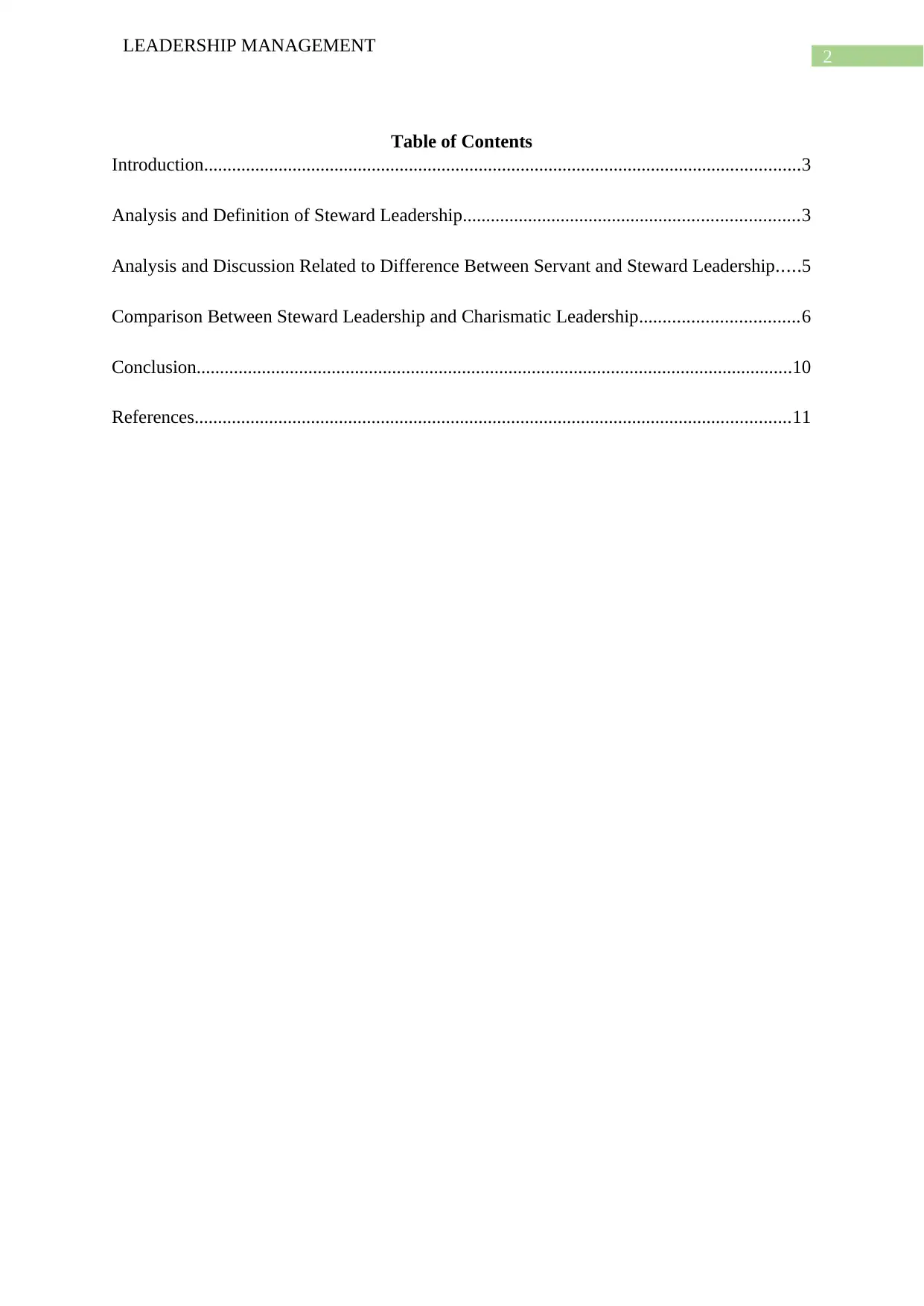
2
LEADERSHIP MANAGEMENT
Table of Contents
Introduction................................................................................................................................3
Analysis and Definition of Steward Leadership........................................................................3
Analysis and Discussion Related to Difference Between Servant and Steward Leadership.....5
Comparison Between Steward Leadership and Charismatic Leadership..................................6
Conclusion................................................................................................................................10
References................................................................................................................................11
LEADERSHIP MANAGEMENT
Table of Contents
Introduction................................................................................................................................3
Analysis and Definition of Steward Leadership........................................................................3
Analysis and Discussion Related to Difference Between Servant and Steward Leadership.....5
Comparison Between Steward Leadership and Charismatic Leadership..................................6
Conclusion................................................................................................................................10
References................................................................................................................................11
⊘ This is a preview!⊘
Do you want full access?
Subscribe today to unlock all pages.

Trusted by 1+ million students worldwide
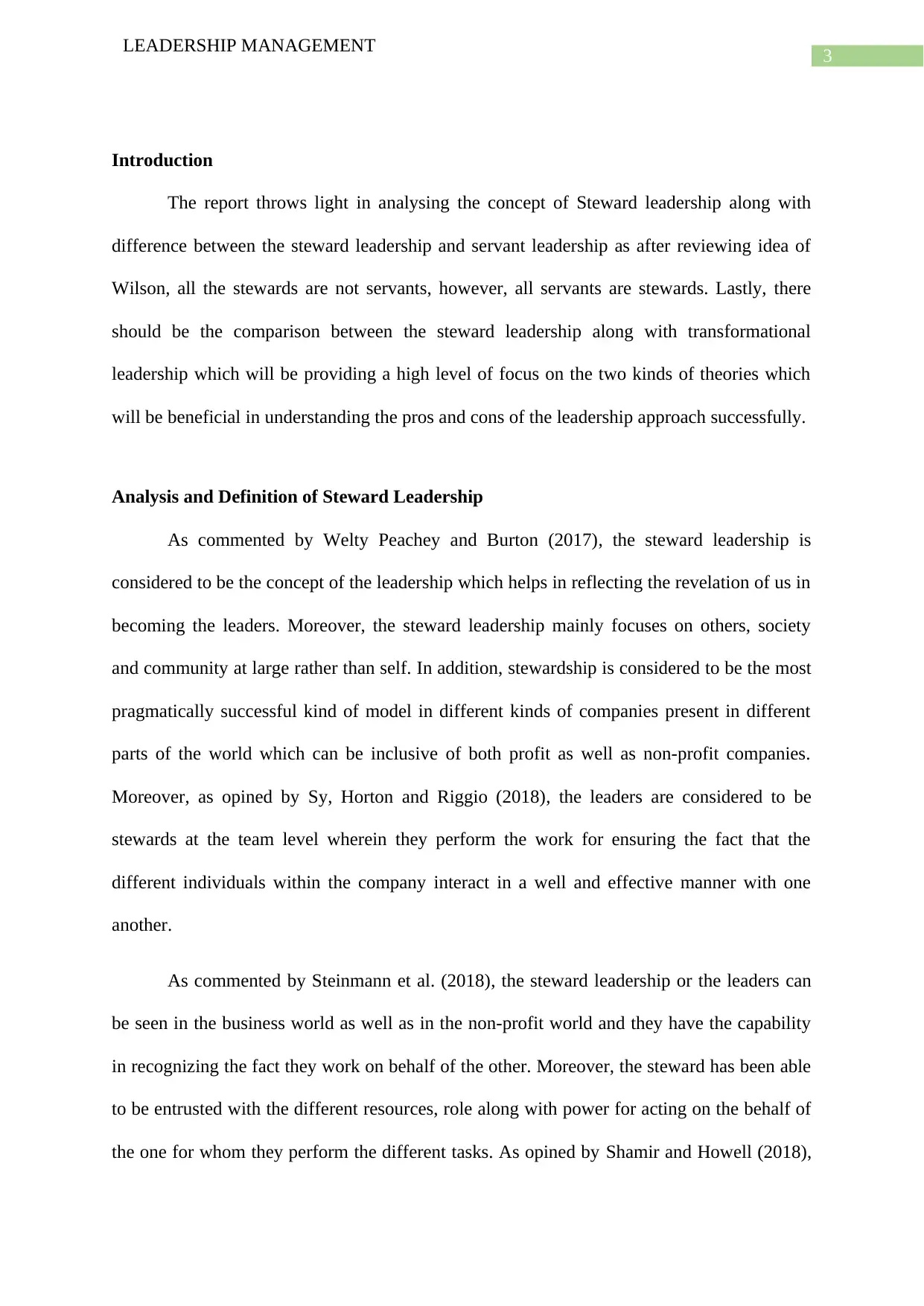
3
LEADERSHIP MANAGEMENT
Introduction
The report throws light in analysing the concept of Steward leadership along with
difference between the steward leadership and servant leadership as after reviewing idea of
Wilson, all the stewards are not servants, however, all servants are stewards. Lastly, there
should be the comparison between the steward leadership along with transformational
leadership which will be providing a high level of focus on the two kinds of theories which
will be beneficial in understanding the pros and cons of the leadership approach successfully.
Analysis and Definition of Steward Leadership
As commented by Welty Peachey and Burton (2017), the steward leadership is
considered to be the concept of the leadership which helps in reflecting the revelation of us in
becoming the leaders. Moreover, the steward leadership mainly focuses on others, society
and community at large rather than self. In addition, stewardship is considered to be the most
pragmatically successful kind of model in different kinds of companies present in different
parts of the world which can be inclusive of both profit as well as non-profit companies.
Moreover, as opined by Sy, Horton and Riggio (2018), the leaders are considered to be
stewards at the team level wherein they perform the work for ensuring the fact that the
different individuals within the company interact in a well and effective manner with one
another.
As commented by Steinmann et al. (2018), the steward leadership or the leaders can
be seen in the business world as well as in the non-profit world and they have the capability
in recognizing the fact they work on behalf of the other. Moreover, the steward has been able
to be entrusted with the different resources, role along with power for acting on the behalf of
the one for whom they perform the different tasks. As opined by Shamir and Howell (2018),
LEADERSHIP MANAGEMENT
Introduction
The report throws light in analysing the concept of Steward leadership along with
difference between the steward leadership and servant leadership as after reviewing idea of
Wilson, all the stewards are not servants, however, all servants are stewards. Lastly, there
should be the comparison between the steward leadership along with transformational
leadership which will be providing a high level of focus on the two kinds of theories which
will be beneficial in understanding the pros and cons of the leadership approach successfully.
Analysis and Definition of Steward Leadership
As commented by Welty Peachey and Burton (2017), the steward leadership is
considered to be the concept of the leadership which helps in reflecting the revelation of us in
becoming the leaders. Moreover, the steward leadership mainly focuses on others, society
and community at large rather than self. In addition, stewardship is considered to be the most
pragmatically successful kind of model in different kinds of companies present in different
parts of the world which can be inclusive of both profit as well as non-profit companies.
Moreover, as opined by Sy, Horton and Riggio (2018), the leaders are considered to be
stewards at the team level wherein they perform the work for ensuring the fact that the
different individuals within the company interact in a well and effective manner with one
another.
As commented by Steinmann et al. (2018), the steward leadership or the leaders can
be seen in the business world as well as in the non-profit world and they have the capability
in recognizing the fact they work on behalf of the other. Moreover, the steward has been able
to be entrusted with the different resources, role along with power for acting on the behalf of
the one for whom they perform the different tasks. As opined by Shamir and Howell (2018),
Paraphrase This Document
Need a fresh take? Get an instant paraphrase of this document with our AI Paraphraser
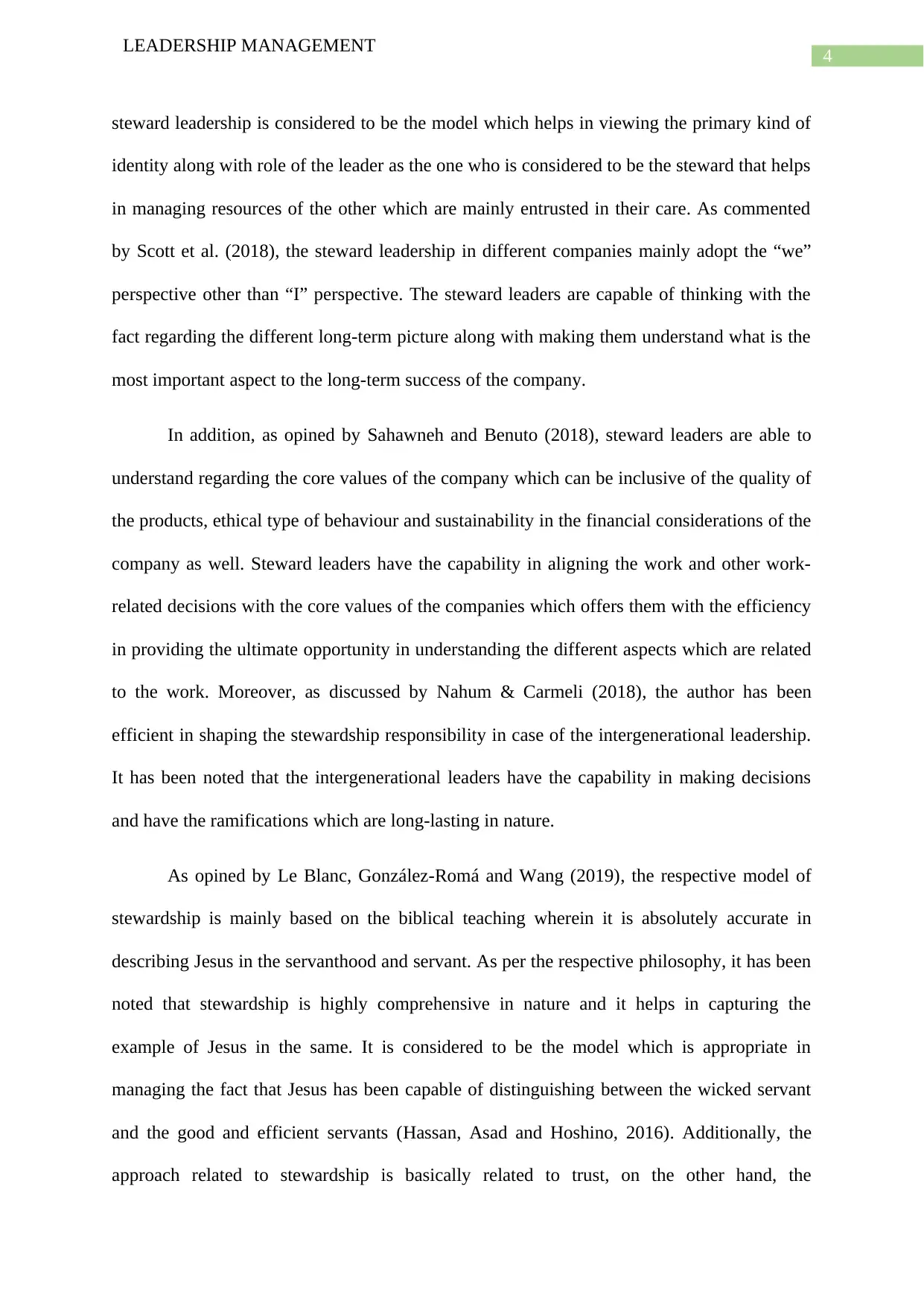
4
LEADERSHIP MANAGEMENT
steward leadership is considered to be the model which helps in viewing the primary kind of
identity along with role of the leader as the one who is considered to be the steward that helps
in managing resources of the other which are mainly entrusted in their care. As commented
by Scott et al. (2018), the steward leadership in different companies mainly adopt the “we”
perspective other than “I” perspective. The steward leaders are capable of thinking with the
fact regarding the different long-term picture along with making them understand what is the
most important aspect to the long-term success of the company.
In addition, as opined by Sahawneh and Benuto (2018), steward leaders are able to
understand regarding the core values of the company which can be inclusive of the quality of
the products, ethical type of behaviour and sustainability in the financial considerations of the
company as well. Steward leaders have the capability in aligning the work and other work-
related decisions with the core values of the companies which offers them with the efficiency
in providing the ultimate opportunity in understanding the different aspects which are related
to the work. Moreover, as discussed by Nahum & Carmeli (2018), the author has been
efficient in shaping the stewardship responsibility in case of the intergenerational leadership.
It has been noted that the intergenerational leaders have the capability in making decisions
and have the ramifications which are long-lasting in nature.
As opined by Le Blanc, González-Romá and Wang (2019), the respective model of
stewardship is mainly based on the biblical teaching wherein it is absolutely accurate in
describing Jesus in the servanthood and servant. As per the respective philosophy, it has been
noted that stewardship is highly comprehensive in nature and it helps in capturing the
example of Jesus in the same. It is considered to be the model which is appropriate in
managing the fact that Jesus has been capable of distinguishing between the wicked servant
and the good and efficient servants (Hassan, Asad and Hoshino, 2016). Additionally, the
approach related to stewardship is basically related to trust, on the other hand, the
LEADERSHIP MANAGEMENT
steward leadership is considered to be the model which helps in viewing the primary kind of
identity along with role of the leader as the one who is considered to be the steward that helps
in managing resources of the other which are mainly entrusted in their care. As commented
by Scott et al. (2018), the steward leadership in different companies mainly adopt the “we”
perspective other than “I” perspective. The steward leaders are capable of thinking with the
fact regarding the different long-term picture along with making them understand what is the
most important aspect to the long-term success of the company.
In addition, as opined by Sahawneh and Benuto (2018), steward leaders are able to
understand regarding the core values of the company which can be inclusive of the quality of
the products, ethical type of behaviour and sustainability in the financial considerations of the
company as well. Steward leaders have the capability in aligning the work and other work-
related decisions with the core values of the companies which offers them with the efficiency
in providing the ultimate opportunity in understanding the different aspects which are related
to the work. Moreover, as discussed by Nahum & Carmeli (2018), the author has been
efficient in shaping the stewardship responsibility in case of the intergenerational leadership.
It has been noted that the intergenerational leaders have the capability in making decisions
and have the ramifications which are long-lasting in nature.
As opined by Le Blanc, González-Romá and Wang (2019), the respective model of
stewardship is mainly based on the biblical teaching wherein it is absolutely accurate in
describing Jesus in the servanthood and servant. As per the respective philosophy, it has been
noted that stewardship is highly comprehensive in nature and it helps in capturing the
example of Jesus in the same. It is considered to be the model which is appropriate in
managing the fact that Jesus has been capable of distinguishing between the wicked servant
and the good and efficient servants (Hassan, Asad and Hoshino, 2016). Additionally, the
approach related to stewardship is basically related to trust, on the other hand, the
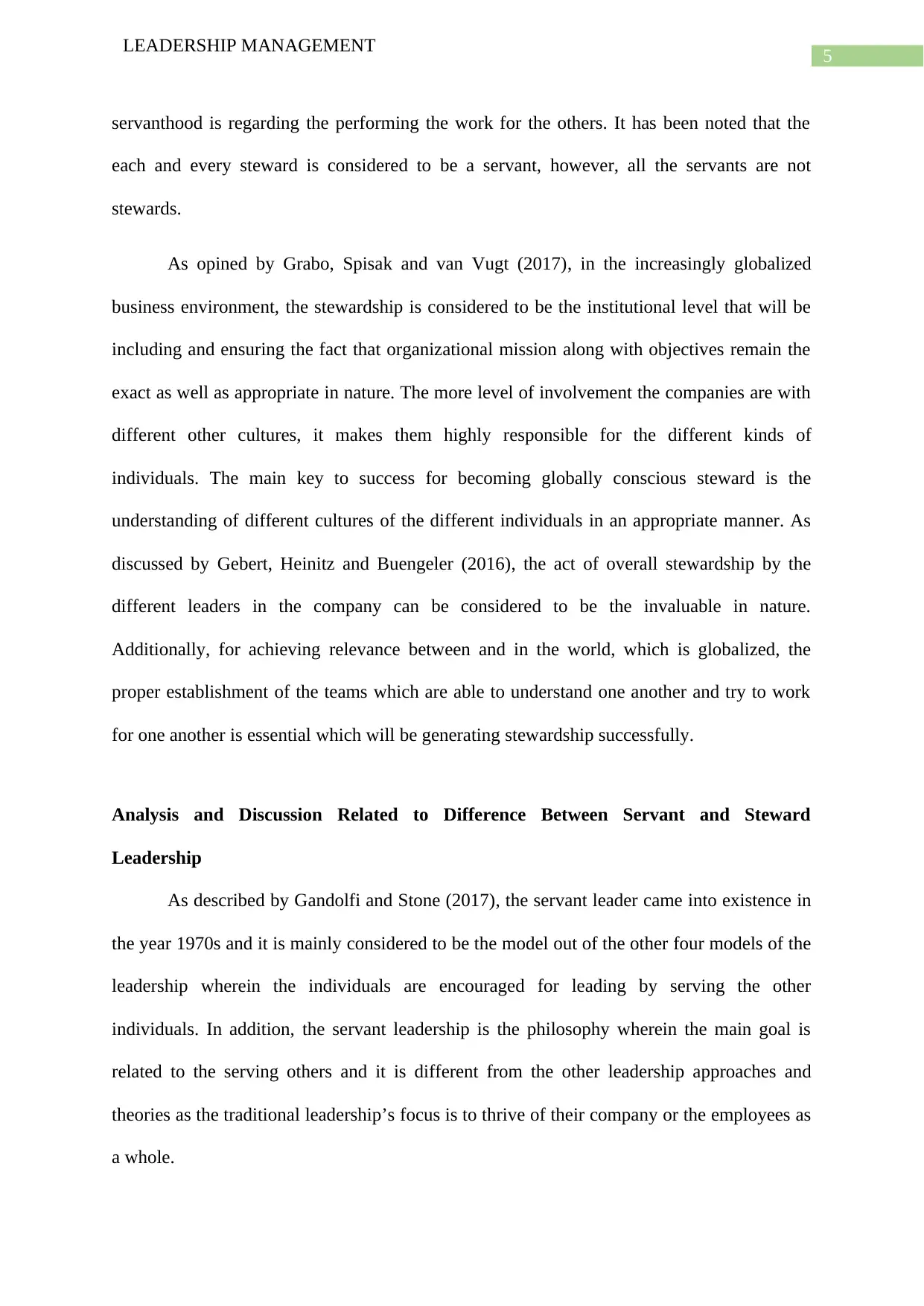
5
LEADERSHIP MANAGEMENT
servanthood is regarding the performing the work for the others. It has been noted that the
each and every steward is considered to be a servant, however, all the servants are not
stewards.
As opined by Grabo, Spisak and van Vugt (2017), in the increasingly globalized
business environment, the stewardship is considered to be the institutional level that will be
including and ensuring the fact that organizational mission along with objectives remain the
exact as well as appropriate in nature. The more level of involvement the companies are with
different other cultures, it makes them highly responsible for the different kinds of
individuals. The main key to success for becoming globally conscious steward is the
understanding of different cultures of the different individuals in an appropriate manner. As
discussed by Gebert, Heinitz and Buengeler (2016), the act of overall stewardship by the
different leaders in the company can be considered to be the invaluable in nature.
Additionally, for achieving relevance between and in the world, which is globalized, the
proper establishment of the teams which are able to understand one another and try to work
for one another is essential which will be generating stewardship successfully.
Analysis and Discussion Related to Difference Between Servant and Steward
Leadership
As described by Gandolfi and Stone (2017), the servant leader came into existence in
the year 1970s and it is mainly considered to be the model out of the other four models of the
leadership wherein the individuals are encouraged for leading by serving the other
individuals. In addition, the servant leadership is the philosophy wherein the main goal is
related to the serving others and it is different from the other leadership approaches and
theories as the traditional leadership’s focus is to thrive of their company or the employees as
a whole.
LEADERSHIP MANAGEMENT
servanthood is regarding the performing the work for the others. It has been noted that the
each and every steward is considered to be a servant, however, all the servants are not
stewards.
As opined by Grabo, Spisak and van Vugt (2017), in the increasingly globalized
business environment, the stewardship is considered to be the institutional level that will be
including and ensuring the fact that organizational mission along with objectives remain the
exact as well as appropriate in nature. The more level of involvement the companies are with
different other cultures, it makes them highly responsible for the different kinds of
individuals. The main key to success for becoming globally conscious steward is the
understanding of different cultures of the different individuals in an appropriate manner. As
discussed by Gebert, Heinitz and Buengeler (2016), the act of overall stewardship by the
different leaders in the company can be considered to be the invaluable in nature.
Additionally, for achieving relevance between and in the world, which is globalized, the
proper establishment of the teams which are able to understand one another and try to work
for one another is essential which will be generating stewardship successfully.
Analysis and Discussion Related to Difference Between Servant and Steward
Leadership
As described by Gandolfi and Stone (2017), the servant leader came into existence in
the year 1970s and it is mainly considered to be the model out of the other four models of the
leadership wherein the individuals are encouraged for leading by serving the other
individuals. In addition, the servant leadership is the philosophy wherein the main goal is
related to the serving others and it is different from the other leadership approaches and
theories as the traditional leadership’s focus is to thrive of their company or the employees as
a whole.
⊘ This is a preview!⊘
Do you want full access?
Subscribe today to unlock all pages.

Trusted by 1+ million students worldwide
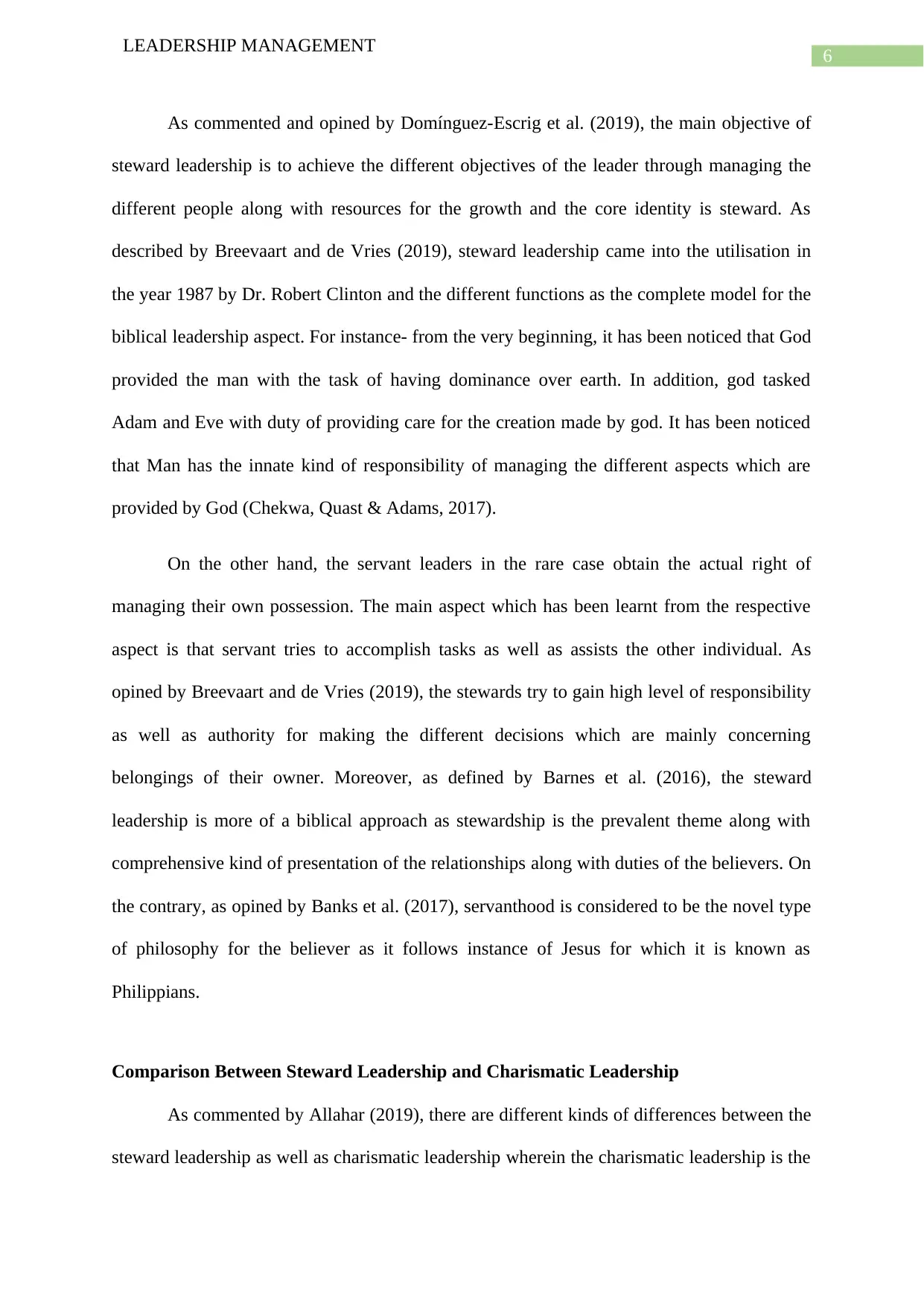
6
LEADERSHIP MANAGEMENT
As commented and opined by Domínguez-Escrig et al. (2019), the main objective of
steward leadership is to achieve the different objectives of the leader through managing the
different people along with resources for the growth and the core identity is steward. As
described by Breevaart and de Vries (2019), steward leadership came into the utilisation in
the year 1987 by Dr. Robert Clinton and the different functions as the complete model for the
biblical leadership aspect. For instance- from the very beginning, it has been noticed that God
provided the man with the task of having dominance over earth. In addition, god tasked
Adam and Eve with duty of providing care for the creation made by god. It has been noticed
that Man has the innate kind of responsibility of managing the different aspects which are
provided by God (Chekwa, Quast & Adams, 2017).
On the other hand, the servant leaders in the rare case obtain the actual right of
managing their own possession. The main aspect which has been learnt from the respective
aspect is that servant tries to accomplish tasks as well as assists the other individual. As
opined by Breevaart and de Vries (2019), the stewards try to gain high level of responsibility
as well as authority for making the different decisions which are mainly concerning
belongings of their owner. Moreover, as defined by Barnes et al. (2016), the steward
leadership is more of a biblical approach as stewardship is the prevalent theme along with
comprehensive kind of presentation of the relationships along with duties of the believers. On
the contrary, as opined by Banks et al. (2017), servanthood is considered to be the novel type
of philosophy for the believer as it follows instance of Jesus for which it is known as
Philippians.
Comparison Between Steward Leadership and Charismatic Leadership
As commented by Allahar (2019), there are different kinds of differences between the
steward leadership as well as charismatic leadership wherein the charismatic leadership is the
LEADERSHIP MANAGEMENT
As commented and opined by Domínguez-Escrig et al. (2019), the main objective of
steward leadership is to achieve the different objectives of the leader through managing the
different people along with resources for the growth and the core identity is steward. As
described by Breevaart and de Vries (2019), steward leadership came into the utilisation in
the year 1987 by Dr. Robert Clinton and the different functions as the complete model for the
biblical leadership aspect. For instance- from the very beginning, it has been noticed that God
provided the man with the task of having dominance over earth. In addition, god tasked
Adam and Eve with duty of providing care for the creation made by god. It has been noticed
that Man has the innate kind of responsibility of managing the different aspects which are
provided by God (Chekwa, Quast & Adams, 2017).
On the other hand, the servant leaders in the rare case obtain the actual right of
managing their own possession. The main aspect which has been learnt from the respective
aspect is that servant tries to accomplish tasks as well as assists the other individual. As
opined by Breevaart and de Vries (2019), the stewards try to gain high level of responsibility
as well as authority for making the different decisions which are mainly concerning
belongings of their owner. Moreover, as defined by Barnes et al. (2016), the steward
leadership is more of a biblical approach as stewardship is the prevalent theme along with
comprehensive kind of presentation of the relationships along with duties of the believers. On
the contrary, as opined by Banks et al. (2017), servanthood is considered to be the novel type
of philosophy for the believer as it follows instance of Jesus for which it is known as
Philippians.
Comparison Between Steward Leadership and Charismatic Leadership
As commented by Allahar (2019), there are different kinds of differences between the
steward leadership as well as charismatic leadership wherein the charismatic leadership is the
Paraphrase This Document
Need a fresh take? Get an instant paraphrase of this document with our AI Paraphraser
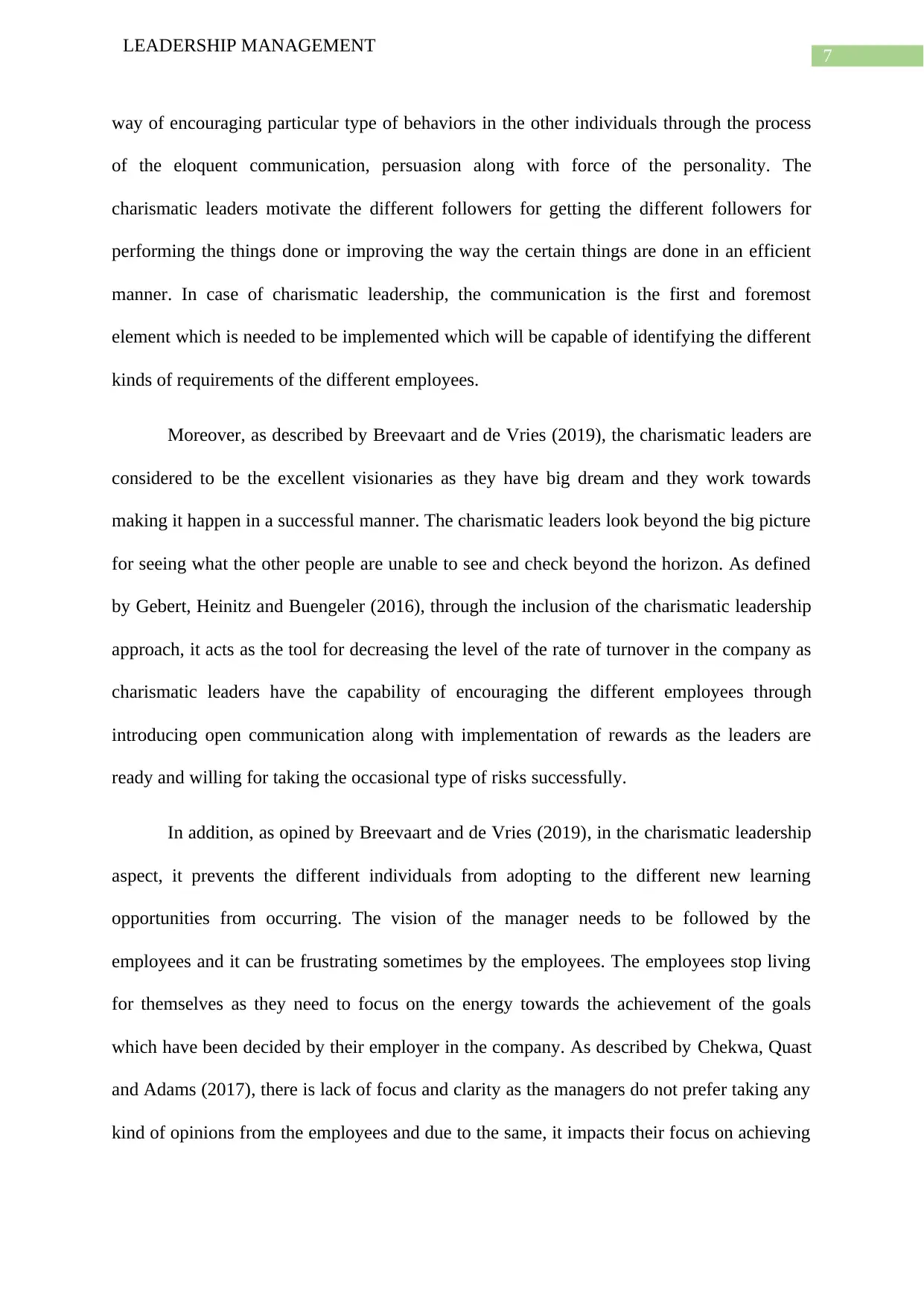
7
LEADERSHIP MANAGEMENT
way of encouraging particular type of behaviors in the other individuals through the process
of the eloquent communication, persuasion along with force of the personality. The
charismatic leaders motivate the different followers for getting the different followers for
performing the things done or improving the way the certain things are done in an efficient
manner. In case of charismatic leadership, the communication is the first and foremost
element which is needed to be implemented which will be capable of identifying the different
kinds of requirements of the different employees.
Moreover, as described by Breevaart and de Vries (2019), the charismatic leaders are
considered to be the excellent visionaries as they have big dream and they work towards
making it happen in a successful manner. The charismatic leaders look beyond the big picture
for seeing what the other people are unable to see and check beyond the horizon. As defined
by Gebert, Heinitz and Buengeler (2016), through the inclusion of the charismatic leadership
approach, it acts as the tool for decreasing the level of the rate of turnover in the company as
charismatic leaders have the capability of encouraging the different employees through
introducing open communication along with implementation of rewards as the leaders are
ready and willing for taking the occasional type of risks successfully.
In addition, as opined by Breevaart and de Vries (2019), in the charismatic leadership
aspect, it prevents the different individuals from adopting to the different new learning
opportunities from occurring. The vision of the manager needs to be followed by the
employees and it can be frustrating sometimes by the employees. The employees stop living
for themselves as they need to focus on the energy towards the achievement of the goals
which have been decided by their employer in the company. As described by Chekwa, Quast
and Adams (2017), there is lack of focus and clarity as the managers do not prefer taking any
kind of opinions from the employees and due to the same, it impacts their focus on achieving
LEADERSHIP MANAGEMENT
way of encouraging particular type of behaviors in the other individuals through the process
of the eloquent communication, persuasion along with force of the personality. The
charismatic leaders motivate the different followers for getting the different followers for
performing the things done or improving the way the certain things are done in an efficient
manner. In case of charismatic leadership, the communication is the first and foremost
element which is needed to be implemented which will be capable of identifying the different
kinds of requirements of the different employees.
Moreover, as described by Breevaart and de Vries (2019), the charismatic leaders are
considered to be the excellent visionaries as they have big dream and they work towards
making it happen in a successful manner. The charismatic leaders look beyond the big picture
for seeing what the other people are unable to see and check beyond the horizon. As defined
by Gebert, Heinitz and Buengeler (2016), through the inclusion of the charismatic leadership
approach, it acts as the tool for decreasing the level of the rate of turnover in the company as
charismatic leaders have the capability of encouraging the different employees through
introducing open communication along with implementation of rewards as the leaders are
ready and willing for taking the occasional type of risks successfully.
In addition, as opined by Breevaart and de Vries (2019), in the charismatic leadership
aspect, it prevents the different individuals from adopting to the different new learning
opportunities from occurring. The vision of the manager needs to be followed by the
employees and it can be frustrating sometimes by the employees. The employees stop living
for themselves as they need to focus on the energy towards the achievement of the goals
which have been decided by their employer in the company. As described by Chekwa, Quast
and Adams (2017), there is lack of focus and clarity as the managers do not prefer taking any
kind of opinions from the employees and due to the same, it impacts their focus on achieving
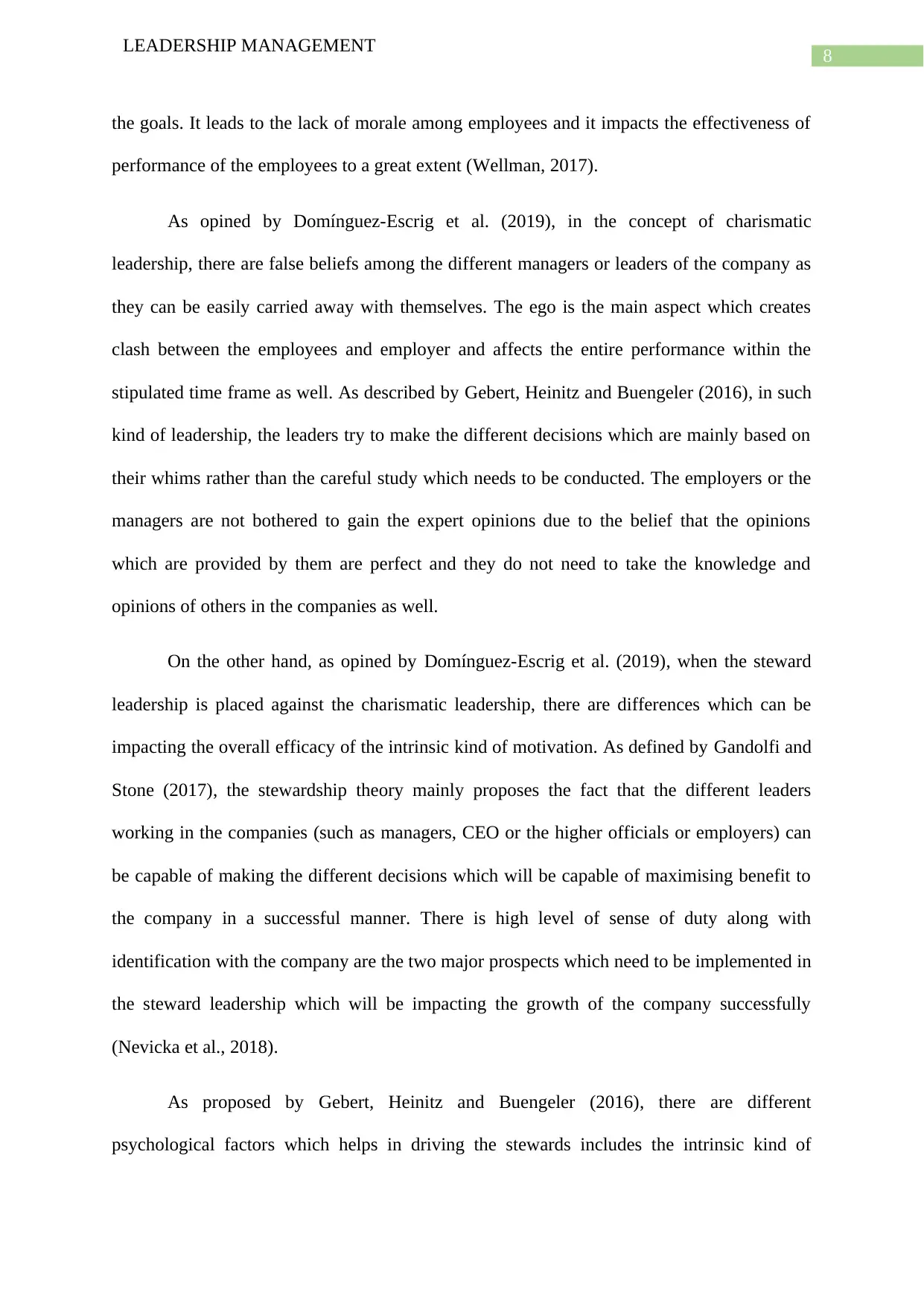
8
LEADERSHIP MANAGEMENT
the goals. It leads to the lack of morale among employees and it impacts the effectiveness of
performance of the employees to a great extent (Wellman, 2017).
As opined by Domínguez-Escrig et al. (2019), in the concept of charismatic
leadership, there are false beliefs among the different managers or leaders of the company as
they can be easily carried away with themselves. The ego is the main aspect which creates
clash between the employees and employer and affects the entire performance within the
stipulated time frame as well. As described by Gebert, Heinitz and Buengeler (2016), in such
kind of leadership, the leaders try to make the different decisions which are mainly based on
their whims rather than the careful study which needs to be conducted. The employers or the
managers are not bothered to gain the expert opinions due to the belief that the opinions
which are provided by them are perfect and they do not need to take the knowledge and
opinions of others in the companies as well.
On the other hand, as opined by Domínguez-Escrig et al. (2019), when the steward
leadership is placed against the charismatic leadership, there are differences which can be
impacting the overall efficacy of the intrinsic kind of motivation. As defined by Gandolfi and
Stone (2017), the stewardship theory mainly proposes the fact that the different leaders
working in the companies (such as managers, CEO or the higher officials or employers) can
be capable of making the different decisions which will be capable of maximising benefit to
the company in a successful manner. There is high level of sense of duty along with
identification with the company are the two major prospects which need to be implemented in
the steward leadership which will be impacting the growth of the company successfully
(Nevicka et al., 2018).
As proposed by Gebert, Heinitz and Buengeler (2016), there are different
psychological factors which helps in driving the stewards includes the intrinsic kind of
LEADERSHIP MANAGEMENT
the goals. It leads to the lack of morale among employees and it impacts the effectiveness of
performance of the employees to a great extent (Wellman, 2017).
As opined by Domínguez-Escrig et al. (2019), in the concept of charismatic
leadership, there are false beliefs among the different managers or leaders of the company as
they can be easily carried away with themselves. The ego is the main aspect which creates
clash between the employees and employer and affects the entire performance within the
stipulated time frame as well. As described by Gebert, Heinitz and Buengeler (2016), in such
kind of leadership, the leaders try to make the different decisions which are mainly based on
their whims rather than the careful study which needs to be conducted. The employers or the
managers are not bothered to gain the expert opinions due to the belief that the opinions
which are provided by them are perfect and they do not need to take the knowledge and
opinions of others in the companies as well.
On the other hand, as opined by Domínguez-Escrig et al. (2019), when the steward
leadership is placed against the charismatic leadership, there are differences which can be
impacting the overall efficacy of the intrinsic kind of motivation. As defined by Gandolfi and
Stone (2017), the stewardship theory mainly proposes the fact that the different leaders
working in the companies (such as managers, CEO or the higher officials or employers) can
be capable of making the different decisions which will be capable of maximising benefit to
the company in a successful manner. There is high level of sense of duty along with
identification with the company are the two major prospects which need to be implemented in
the steward leadership which will be impacting the growth of the company successfully
(Nevicka et al., 2018).
As proposed by Gebert, Heinitz and Buengeler (2016), there are different
psychological factors which helps in driving the stewards includes the intrinsic kind of
⊘ This is a preview!⊘
Do you want full access?
Subscribe today to unlock all pages.

Trusted by 1+ million students worldwide
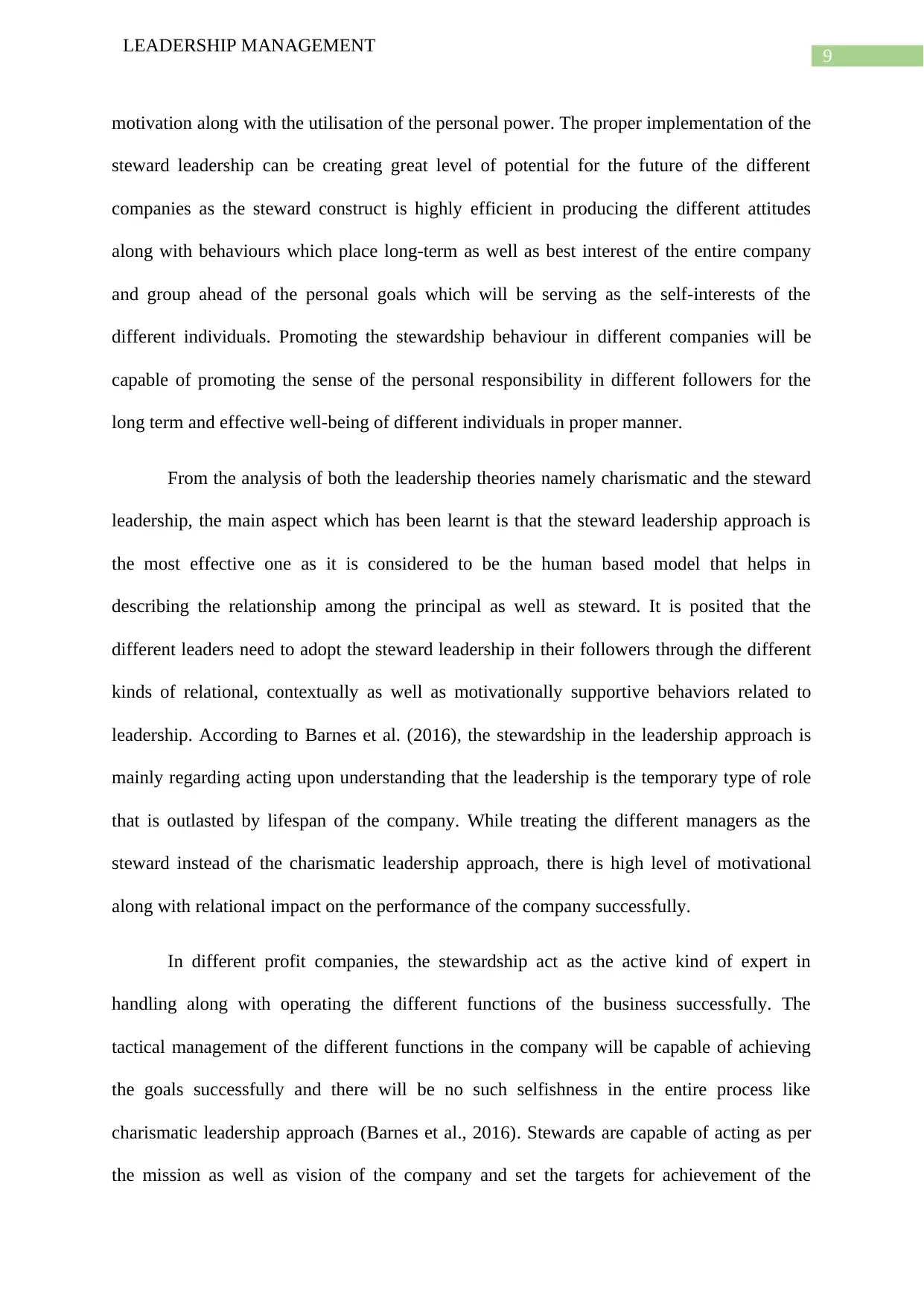
9
LEADERSHIP MANAGEMENT
motivation along with the utilisation of the personal power. The proper implementation of the
steward leadership can be creating great level of potential for the future of the different
companies as the steward construct is highly efficient in producing the different attitudes
along with behaviours which place long-term as well as best interest of the entire company
and group ahead of the personal goals which will be serving as the self-interests of the
different individuals. Promoting the stewardship behaviour in different companies will be
capable of promoting the sense of the personal responsibility in different followers for the
long term and effective well-being of different individuals in proper manner.
From the analysis of both the leadership theories namely charismatic and the steward
leadership, the main aspect which has been learnt is that the steward leadership approach is
the most effective one as it is considered to be the human based model that helps in
describing the relationship among the principal as well as steward. It is posited that the
different leaders need to adopt the steward leadership in their followers through the different
kinds of relational, contextually as well as motivationally supportive behaviors related to
leadership. According to Barnes et al. (2016), the stewardship in the leadership approach is
mainly regarding acting upon understanding that the leadership is the temporary type of role
that is outlasted by lifespan of the company. While treating the different managers as the
steward instead of the charismatic leadership approach, there is high level of motivational
along with relational impact on the performance of the company successfully.
In different profit companies, the stewardship act as the active kind of expert in
handling along with operating the different functions of the business successfully. The
tactical management of the different functions in the company will be capable of achieving
the goals successfully and there will be no such selfishness in the entire process like
charismatic leadership approach (Barnes et al., 2016). Stewards are capable of acting as per
the mission as well as vision of the company and set the targets for achievement of the
LEADERSHIP MANAGEMENT
motivation along with the utilisation of the personal power. The proper implementation of the
steward leadership can be creating great level of potential for the future of the different
companies as the steward construct is highly efficient in producing the different attitudes
along with behaviours which place long-term as well as best interest of the entire company
and group ahead of the personal goals which will be serving as the self-interests of the
different individuals. Promoting the stewardship behaviour in different companies will be
capable of promoting the sense of the personal responsibility in different followers for the
long term and effective well-being of different individuals in proper manner.
From the analysis of both the leadership theories namely charismatic and the steward
leadership, the main aspect which has been learnt is that the steward leadership approach is
the most effective one as it is considered to be the human based model that helps in
describing the relationship among the principal as well as steward. It is posited that the
different leaders need to adopt the steward leadership in their followers through the different
kinds of relational, contextually as well as motivationally supportive behaviors related to
leadership. According to Barnes et al. (2016), the stewardship in the leadership approach is
mainly regarding acting upon understanding that the leadership is the temporary type of role
that is outlasted by lifespan of the company. While treating the different managers as the
steward instead of the charismatic leadership approach, there is high level of motivational
along with relational impact on the performance of the company successfully.
In different profit companies, the stewardship act as the active kind of expert in
handling along with operating the different functions of the business successfully. The
tactical management of the different functions in the company will be capable of achieving
the goals successfully and there will be no such selfishness in the entire process like
charismatic leadership approach (Barnes et al., 2016). Stewards are capable of acting as per
the mission as well as vision of the company and set the targets for achievement of the
Paraphrase This Document
Need a fresh take? Get an instant paraphrase of this document with our AI Paraphraser
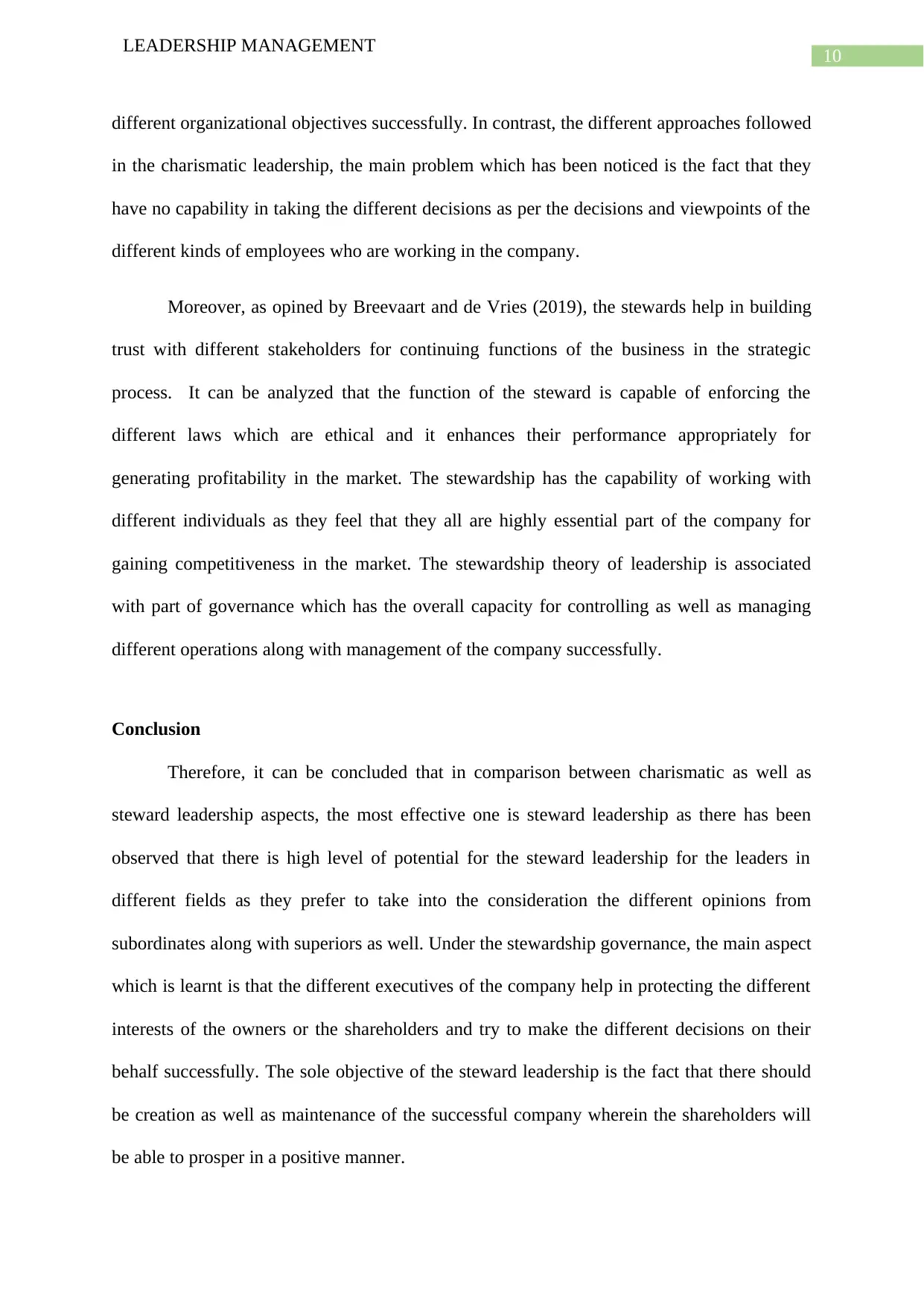
10
LEADERSHIP MANAGEMENT
different organizational objectives successfully. In contrast, the different approaches followed
in the charismatic leadership, the main problem which has been noticed is the fact that they
have no capability in taking the different decisions as per the decisions and viewpoints of the
different kinds of employees who are working in the company.
Moreover, as opined by Breevaart and de Vries (2019), the stewards help in building
trust with different stakeholders for continuing functions of the business in the strategic
process. It can be analyzed that the function of the steward is capable of enforcing the
different laws which are ethical and it enhances their performance appropriately for
generating profitability in the market. The stewardship has the capability of working with
different individuals as they feel that they all are highly essential part of the company for
gaining competitiveness in the market. The stewardship theory of leadership is associated
with part of governance which has the overall capacity for controlling as well as managing
different operations along with management of the company successfully.
Conclusion
Therefore, it can be concluded that in comparison between charismatic as well as
steward leadership aspects, the most effective one is steward leadership as there has been
observed that there is high level of potential for the steward leadership for the leaders in
different fields as they prefer to take into the consideration the different opinions from
subordinates along with superiors as well. Under the stewardship governance, the main aspect
which is learnt is that the different executives of the company help in protecting the different
interests of the owners or the shareholders and try to make the different decisions on their
behalf successfully. The sole objective of the steward leadership is the fact that there should
be creation as well as maintenance of the successful company wherein the shareholders will
be able to prosper in a positive manner.
LEADERSHIP MANAGEMENT
different organizational objectives successfully. In contrast, the different approaches followed
in the charismatic leadership, the main problem which has been noticed is the fact that they
have no capability in taking the different decisions as per the decisions and viewpoints of the
different kinds of employees who are working in the company.
Moreover, as opined by Breevaart and de Vries (2019), the stewards help in building
trust with different stakeholders for continuing functions of the business in the strategic
process. It can be analyzed that the function of the steward is capable of enforcing the
different laws which are ethical and it enhances their performance appropriately for
generating profitability in the market. The stewardship has the capability of working with
different individuals as they feel that they all are highly essential part of the company for
gaining competitiveness in the market. The stewardship theory of leadership is associated
with part of governance which has the overall capacity for controlling as well as managing
different operations along with management of the company successfully.
Conclusion
Therefore, it can be concluded that in comparison between charismatic as well as
steward leadership aspects, the most effective one is steward leadership as there has been
observed that there is high level of potential for the steward leadership for the leaders in
different fields as they prefer to take into the consideration the different opinions from
subordinates along with superiors as well. Under the stewardship governance, the main aspect
which is learnt is that the different executives of the company help in protecting the different
interests of the owners or the shareholders and try to make the different decisions on their
behalf successfully. The sole objective of the steward leadership is the fact that there should
be creation as well as maintenance of the successful company wherein the shareholders will
be able to prosper in a positive manner.

11
LEADERSHIP MANAGEMENT
LEADERSHIP MANAGEMENT
⊘ This is a preview!⊘
Do you want full access?
Subscribe today to unlock all pages.

Trusted by 1+ million students worldwide
1 out of 15
Related Documents
Your All-in-One AI-Powered Toolkit for Academic Success.
+13062052269
info@desklib.com
Available 24*7 on WhatsApp / Email
![[object Object]](/_next/static/media/star-bottom.7253800d.svg)
Unlock your academic potential
Copyright © 2020–2025 A2Z Services. All Rights Reserved. Developed and managed by ZUCOL.





